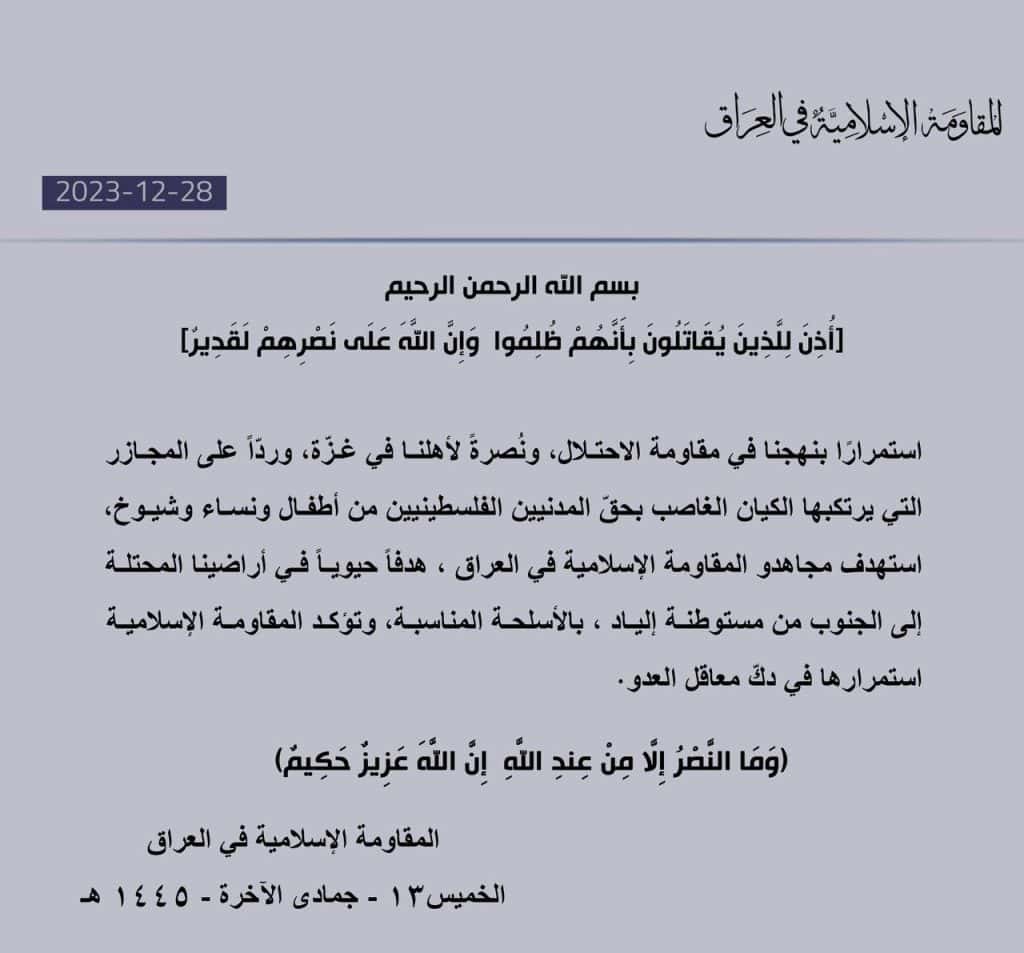
The “Islamic Resistance in Iraq,” a network of Iranian proxies, front groups, and other pro-Iranian actors claimed responsibility for attacking an undisclosed target in the southern Golan Heights on Dec. 27.
“The mujahideen of the Islamic Resistance in Iraq targeted a vital site in our occupied territories to the south of the Eliad settlement, with appropriate weapons,” the group claimed in a statement published on Telegram.
Local Israeli media reported that Israel Defense Forces troops located an explosive-laden drone in an “open area” in the southern Golan Heights and that it was apparently launched from Syrian territory.
While the name of the group implies that is solely based out of Iraq, the Islamic Resistance in Iraq is comprised of Iranian proxy terror organizations that are based in both Iraq and Syria. For instance, Asaib Ahl al Haq and Hezbollah Brigades are based in Iraq, while Harakat Hezbollah al Nujaba and Kata’ib Sayyid al-Shuhada are primarily based in Syria. However these groups are known to operate in both countries. [For more information on the Iranian-backed militias in Iraq and Syria, see FDD’s Long War Journal report, Profiles of 15 Iranian-backed Militias in the Middle East.]
Since the beginning of the Oct. 7 war, several security incidents involving Iranian-backed groups firing projectiles from Syrian and Iraqi territory have occurred. Notably, the IDF said that on Dec. 15 it intercepted a UAV “on its way to Israeli territory” over Lebanese-controlled waters in the Mediterranean Sea. Initially, it appeared to be another Hezbollah attempt to attack Israel. However, the Islamic Resistance in Iraq published a statement on Dec. 22 saying it “achieved a direct hit” on a “vital target in the Mediterranean Sea a few days ago.”
While the Islamic Resistance in Iraq claimed in its Dec. 27 statement that the attack was in response to its “continuation of resisting the occupation,” it’s difficult to overlook that Iran vowed to retaliate against Israel following the targeted killing of senior IRGC officer Reza Mousavi near Damascus on Dec. 25.
On Dec. 26, Iranian President Ebrahim Raisi expressed that “Israel will face the consequences for Mousavi’s death.” Moreover, Foreign Minister Hossein Amir-Abdollahian emphasized that Tel Aviv should prepare for a “powerful and formidable countdown.”
Further strengthening the possibility that the drone strike in the southern Golan Heights was a part of a retaliatory act for the killing of Mousavi, the Islamic Resistance in Iraq also stated on Dec. 27 that it had launched an attack on an Israeli-affiliated “technical spy center” located northeast of Erbil, Iraq. It is worth noting this marks the second time that Iran or an Iranian-backed group has admitted to attacking an alleged Israeli site in Erbil.
As the IDF slowly dismantles Hamas and other Palestinian terrorist groups in Gaza, Iran’s network of clients in the region are stepping up their attacks against Israel and its allies.The Houthis in Yemen are attempting to establish a naval blockade in the Red Sea under the guise of supporting Palestinians in the Gaza Strip. Hezbollah, has stepped up its attacks against northern Israel, while Iranian-backed militias in Syria and Iraq have directed their aggression towards U.S. and Israeli positions.
Defense Minister Yoav Gallant described the situation succinctly on Dec. 26, saying that Israel is in a multi-front war, facing attacks from seven different theaters. And while these actors are launching attacks from different fronts, it is abundantly clear that Iran is the common denominator, with its influence evident in all of these arenas.







